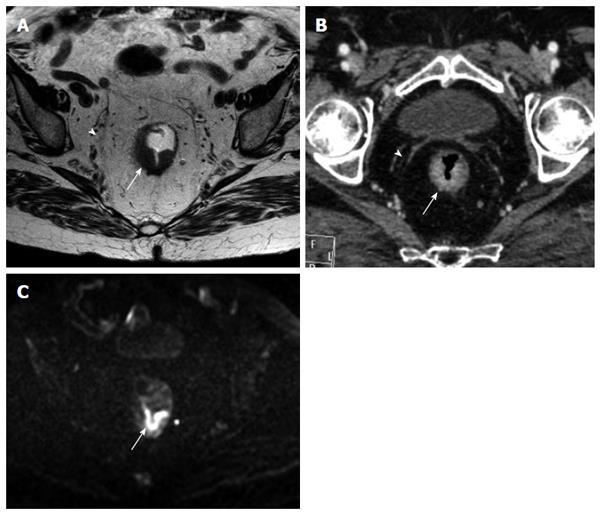Copyright
©The Author(s) 2016.
World J Gastroenterol. May 28, 2016; 22(20): 4891-4900
Published online May 28, 2016. doi: 10.3748/wjg.v22.i20.4891
Published online May 28, 2016. doi: 10.3748/wjg.v22.i20.4891
Figure 3 Images obtained in an 86 year-old woman with middle rectal cancer.
A: Orthogonal axial high-resolution T2-weighted MR image shows the tumor as a thickening (arrow) along the posterior aspect of the rectum, infiltrating through the muscularis propria (the band of proper muscle layer (*) is destroyed) into the mesorectal fat. The mesorectal fascia is seen as a thin hypointense line (arrowhead) surrounding the mesorectal fat; B: Multiplanar reconstruction (MPR) para-axial contrast enhanced computed tomography image of the same patient shows the tumour as an irregular mural thickening of the posterior rectal wall with spiculations extending into the peri-rectal fat. The mesorectal fascia is well defined and not involved (arrowhead); C: DWIBS image (b-value 1000), the tumor (arrow) is clearly recognizable as high signal in comparison with the lower signal intensity of the normal rectal wall.
- Citation: Ippolito D, Drago SG, Franzesi CT, Fior D, Sironi S. Rectal cancer staging: Multidetector-row computed tomography diagnostic accuracy in assessment of mesorectal fascia invasion. World J Gastroenterol 2016; 22(20): 4891-4900
- URL: https://www.wjgnet.com/1007-9327/full/v22/i20/4891.htm
- DOI: https://dx.doi.org/10.3748/wjg.v22.i20.4891









